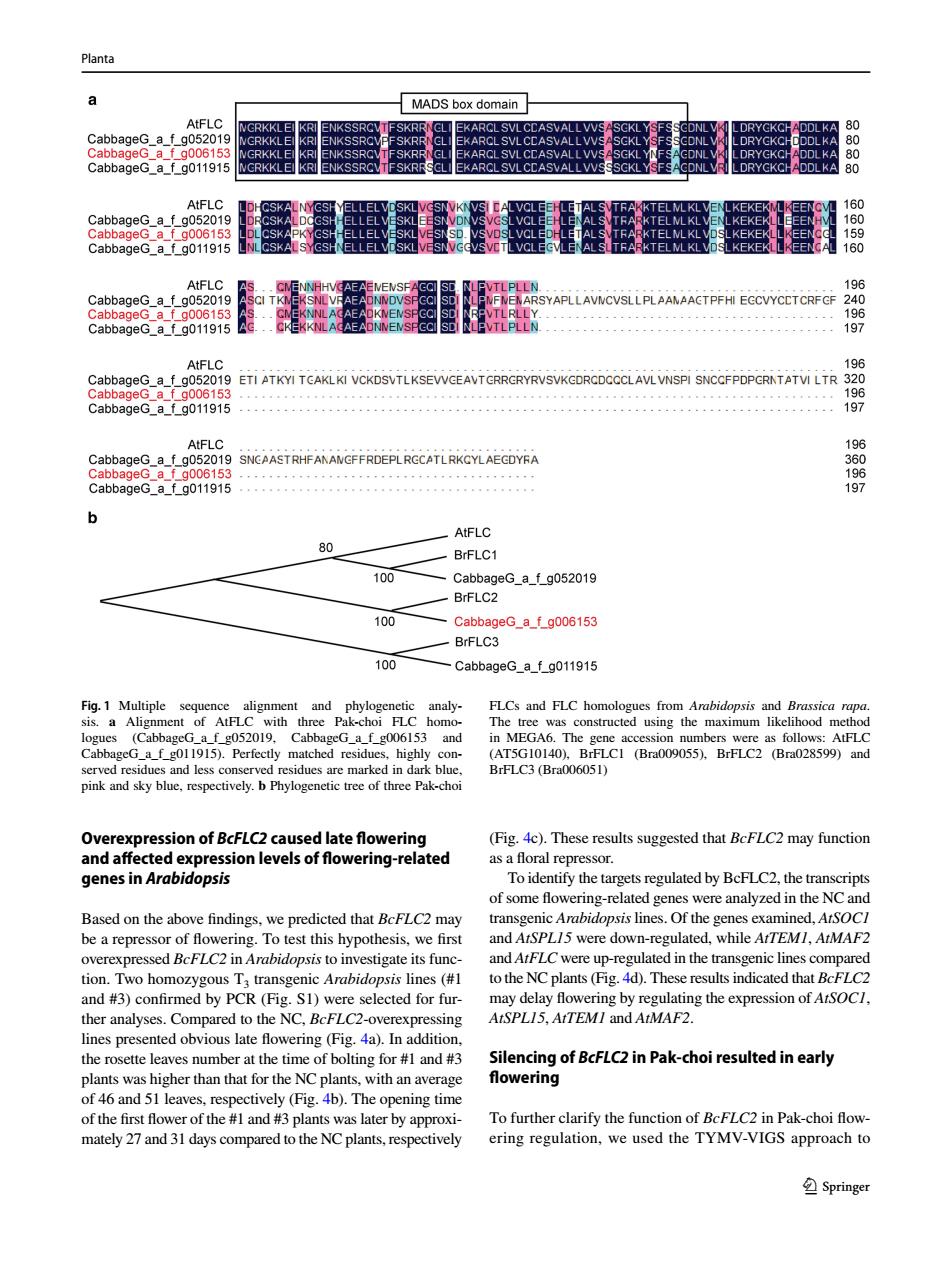正在加载图片...

Planta a MADS box domain AtFLC VGRKKLEI EKARCL SVLCCASVALLVVS OOKA 80 CabbageG_a_f_g052019 SKRRN ARCL SVLCCASVALLVV SCKL DNL 80 CabbageG a_f g006153 NGRKKL EI ENKSSRCVT KA周SASA DOLKA 80 CabbageG a_f_g011915 KARCL SVLCDASVALLVVSSSCKLYS 80 AtFLC EN 160 CabbageG a f g052019 160 CabbageG_a_f_g006153 159 CabbageG_a_f_g011915 LKEKEK 160 AtFLC AS 196 CabbageG a f g052019 CI TKME JNDVSHEe iMFNEMARSYAPLLAVNCVSLLPLAANAACTPFHI ECCVYCCTCRFCF 240 CabbageG a f g006153 AS 196 CabbageG a f g011915 EVTLPLLN 197 AtFLC 196 CabbageG a_f g052019 ETI ATKYI TCAKLKI VCKDSVTLKSEVVCEAVTGRRGRYRVSVKGDRCDCCCLAVL VNSPI SNCCFPDPGRNTATVI LTR 320 CabbageG_a_f_g006153 196 CabbageG a_f_g011915 197 AtFLC 196 CabbageG_a_f_g052019 SNGAASTRHFANANCFFRDEPLRGCATLRKCYLAECDYRA 360 CabbageG a f g006153 196 CabbageG_a_f_g011915 197 AtFLC 80 BrFLC1 100 CabbageG_a_f_g052019 BrFLC2 100 CabbageG a f g006153 BrFLC3 100 CabbageG a f g011915 Fig.1 Multiple sequence alignment and phylogenctic analy- FLCs and FLC homologues from Arabidopsis and Brassica rapa. sis.a Alignment of AtFLC with three Pak-choi FLC homo- The tree was constructed using the maximum likelihood method logues (CabbageG a f g052019.CabbageG a f g006153 and in MEGA6.The gene accession numbers were as follows:AtFLC CabbageG a f gol1915).Perfectly matched residues.highly con- (AT5G10140).BrFLCI (Bra009055).BrFLC2 (Bra028599)and served residues and less conserved residues are marked in dark blue BrFLC3(Bra006051) pink and sky blue,respectively.b Phylogenetic tree of three Pak-choi Overexpression of BcFLC2 caused late flowering (Fig.4c).These results suggested that BcFLC2 may function and affected expression levels of flowering-related as a floral repressor. genes in Arabidopsis To identify the targets regulated by BcFLC2,the transcripts of some flowering-related genes were analyzed in the NC and Based on the above findings,we predicted that BcFLC2 may transgenic Arabidopsis lines.Of the genes examined,AtSOCI be a repressor of flowering.To test this hypothesis,we first and AtSPL15 were down-regulated.while AtTEM/.AtMAF2 overexpressed BcFLC2 in Arabidopsis to investigate its func- and AtFLC were up-regulated in the transgenic lines compared tion.Two homozygous T3 transgenic Arabidopsis lines (#1 to the NC plants(Fig.4d).These results indicated that BcFLC2 and #3)confirmed by PCR(Fig.S1)were selected for fur- may delay flowering by regulating the expression of AtSOCl, ther analyses.Compared to the NC,BcFLC2-overexpressing AtSPL15.AtTEMI and AtMAF2. lines presented obvious late flowering(Fig.4a).In addition. the rosette leaves number at the time of bolting for #1 and #3 Silencing of BcFLC2 in Pak-choi resulted in early plants was higher than that for the NC plants,with an average flowering of 46 and 51 leaves,respectively (Fig.4b).The opening time of the first flower of the #1 and #3 plants was later by approxi- To further clarify the function of BcFLC2 in Pak-choi flow- mately 27 and 31 days compared to the NC plants,respectively ering regulation,we used the TYMV-VIGS approach to SpringerPlanta 1 3 Overexpression of BcFLC2 caused late fowering and afected expression levels of fowering‑related genes in Arabidopsis Based on the above fndings, we predicted that BcFLC2 may be a repressor of fowering. To test this hypothesis, we frst overexpressed BcFLC2 in Arabidopsis to investigate its function. Two homozygous T3 transgenic Arabidopsis lines (#1 and #3) confrmed by PCR (Fig. S1) were selected for further analyses. Compared to the NC, BcFLC2-overexpressing lines presented obvious late fowering (Fig. 4a). In addition, the rosette leaves number at the time of bolting for #1 and #3 plants was higher than that for the NC plants, with an average of 46 and 51 leaves, respectively (Fig. 4b). The opening time of the frst fower of the #1 and #3 plants was later by approximately 27 and 31 days compared to the NC plants, respectively (Fig. 4c). These results suggested that BcFLC2 may function as a foral repressor. To identify the targets regulated by BcFLC2, the transcripts of some fowering-related genes were analyzed in the NC and transgenic Arabidopsis lines. Of the genes examined, AtSOC1 and AtSPL15 were down-regulated, while AtTEM1, AtMAF2 and AtFLC were up-regulated in the transgenic lines compared to the NC plants (Fig. 4d). These results indicated that BcFLC2 may delay fowering by regulating the expression of AtSOC1, AtSPL15, AtTEM1 and AtMAF2. Silencing of BcFLC2 in Pak‑choi resulted in early fowering To further clarify the function of BcFLC2 in Pak-choi fowering regulation, we used the TYMV-VIGS approach to Fig. 1 Multiple sequence alignment and phylogenetic analysis. a Alignment of AtFLC with three Pak-choi FLC homologues (CabbageG_a_f_g052019, CabbageG_a_f_g006153 and CabbageG_a_f_g011915). Perfectly matched residues, highly conserved residues and less conserved residues are marked in dark blue, pink and sky blue, respectively. b Phylogenetic tree of three Pak-choi FLCs and FLC homologues from Arabidopsis and Brassica rapa. The tree was constructed using the maximum likelihood method in MEGA6. The gene accession numbers were as follows: AtFLC (AT5G10140), BrFLC1 (Bra009055), BrFLC2 (Bra028599) and BrFLC3 (Bra006051)